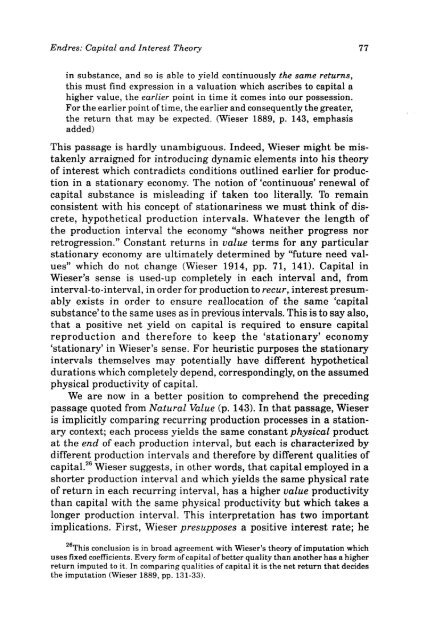Review of Austrian Economics - The Ludwig von Mises Institute
Review of Austrian Economics - The Ludwig von Mises Institute
Review of Austrian Economics - The Ludwig von Mises Institute
Create successful ePaper yourself
Turn your PDF publications into a flip-book with our unique Google optimized e-Paper software.
Endres: Capital and Interest <strong>The</strong>ory 77<br />
in substance, and so is able to yield continuously the same returns,<br />
this must find expression in a valuation which ascribes to capital a<br />
higher value, the earlier point in time it comes into our possession.<br />
For the earlier point <strong>of</strong> time, the earlier and consequently the greater,<br />
the return that may be expected. (Wieser 1889, p. 143, emphasis<br />
added)<br />
This passage is hardly unambiguous. Indeed, Wieser might be mistakenly<br />
arraigned for introducing dynamic elements into his theory<br />
<strong>of</strong> interest which contradicts conditions outlined earlier for production<br />
in a stationary economy. <strong>The</strong> notion <strong>of</strong> 'continuous' renewal <strong>of</strong><br />
capital substance is misleading if taken too literally. To remain<br />
consistent with his concept <strong>of</strong> stationariness we must think <strong>of</strong> discrete,<br />
hypothetical production intervals. Whatever the length <strong>of</strong><br />
the production interval the economy "shows neither progress nor<br />
retrogression." Constant returns in value terms for any particular<br />
stationary economy are ultimately determined by "future need values"<br />
which do not change (Wieser 1914, pp. 71, 141). Capital in<br />
Wieser's sense is used-up completely in each interval and, from<br />
interval-to-interval, in order for production to recur, interest presumably<br />
exists in order to ensure reallocation <strong>of</strong> the same 'capital<br />
substance' to the same uses as in previous intervals. This is to say also,<br />
that a positive net yield on capital is required to ensure capital<br />
reproduction and therefore to keep the 'stationary' economy<br />
'stationary' in Wieser's sense. For heuristic purposes the stationary<br />
intervals themselves may potentially have different hypothetical<br />
durations which completely depend, correspondingly, on the assumed<br />
physical productivity <strong>of</strong> capital.<br />
We are now in a better position to comprehend the preceding<br />
passage quoted from Natural Value (p. 143). In that passage, Wieser<br />
is implicitly comparing recurring production processes in a stationary<br />
context; each process yields the same constant physical product<br />
at the end <strong>of</strong> each production interval, but each is characterized by<br />
different production intervals and therefore by different qualities <strong>of</strong><br />
capital. 26 Wieser suggests, in other words, that capital employed in a<br />
shorter production interval and which yields the same physical rate<br />
<strong>of</strong> return in each recurring interval, has a higher value productivity<br />
than capital with the same physical productivity but which takes a<br />
longer production interval. This interpretation has two important<br />
implications. First, Wieser presupposes a positive interest rate; he<br />
This conclusion is in broad agreement with Wieser's theory <strong>of</strong> imputation which<br />
uses fixed coefficients. Every form <strong>of</strong> capital <strong>of</strong> better quality than another has a higher<br />
return imputed to it. In comparing qualities <strong>of</strong> capital it is the net return that decides<br />
the imputation (Wieser 1889, pp. 131-33).

















